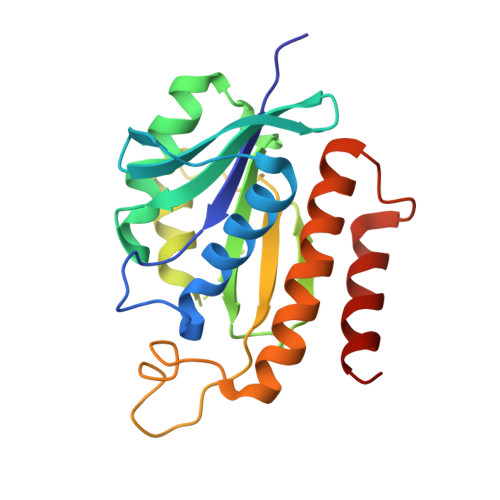Structural analysis of the group II intron splicing factor CRS2 yields insights into its protein and RNA interaction surfaces
Ostheimer, G.J., Hadjivasiliou, H., Kloer, D.P., Barkan, A., Matthews, B.W.(2005) J Mol Biol 345: 51-68
- PubMed: 15567410
- DOI: https://doi.org/10.1016/j.jmb.2004.10.032
- Primary Citation of Related Structures:
1RYB, 1RYM, 1RYN - PubMed Abstract:
Chloroplast RNA splicing 2 (CRS2) is a nuclear-encoded protein required for the splicing of nine group II introns in maize chloroplasts. CRS2 functions in the context of splicing complexes that include one of two CRS2-associated factors (CAF1 and CAF2). The CRS2-CAF1 and CRS2-CAF2 complexes are required for the splicing of different subsets of CRS2-dependent introns, and they bind tightly and specifically to their genetically defined intron targets in vivo. The CRS2 amino acid sequence is closely related to those of bacterial peptidyl-tRNA hydrolases (PTHs). To identify the structural differences between CRS2 and bacterial PTHs responsible for CRS2's gains of CAF binding and intron splicing functions, we determined the structure of CRS2 by X-ray crystallography. The fold of CRS2 is the same as that of Escherichia coli PTH, but CRS2 has two surfaces that differ from the corresponding surfaces in PTH. One of these is more hydrophobic in CRS2 than in PTH. Site-directed mutagenesis of this surface blocked CRS2-CAF complex formation, indicating that it is the CAF binding site. The CRS2 surface corresponding to the putative tRNA binding face of PTH is considerably more basic than in PTH, suggesting that CRS2 interacts with group II intron substrates via this surface. Both the sequence and the structural context of the amino acid residues essential for peptidyl-tRNA hydrolase activity are conserved in CRS2, yet expression of CRS2 is incapable of rescuing a pth(ts)E.coli strain.
Organizational Affiliation:
Institute of Molecular Biology, University of Oregon, Eugene, OR 97403, USA.














